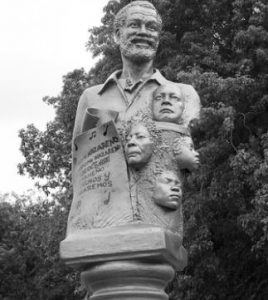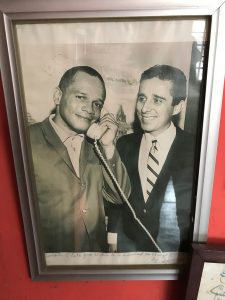This post is also available in:
 Español
Español
In the late ‘60s, Sorolo played a central part of a small miracle that gave way to Ismael Rivera’s legendary song of “El Nazareno”.
The song has always been one of my favorite Salsa songs. It has a beautiful timeless message of faith vs. the superficiality and hypocrisy of society. Ismael always sang it very passionately. After visiting Panama, I now know the full story and understand why.
My wife and I had a chance to travel to Panama recently. We only stayed there 2 days (not enough), but had a chance to meet Sorolo and hear this fascinating story.
To keep this post reasonably short, I’ll tell the story in two blogs; this introduction and the next one on what I consider the miracles of this story.
Who is Sorolo?
The guy at the center of this miraculous story is Pedro Rodriguez, a humble and gregarious Panamanian in his late 80’s. Everyone in El Chorrillo neighborhood knows him by the nickname of “Sorolo”.
It was Sorolo who introduced the Cristo Negro de Portobelo to Ismael Rivera. This happened at a time when Ismael was so deeply immersed in drugs that his body was quite deteriorated. Maelo could barely function without being under the influence of H.
The Miraculous Cristo Negro de Portobelo
So the story of how the Cristo Negro (Black Christ) did for Maelo what 3 years in Federal prison couldn’t do was a story I didn’t want to miss.

Sorolo tells the story of how Ismael Rivera was finally able to kick his many years of drug addiction after meeting the Cristo Negro.
The tales of miracles by the Cristo Negro go back to its arrival to Portobelo around the 17th century.
One of the legends says that it came from Spain to the new world on a Colombian ship. The ship made a stop in Portobelo but then had problems continuing its trip. Every time it tried to sail, a storm would come in.
The sailors decided to leave the statue behind after this occurred several times. After leaving it in Portobelo, the ship was able to sail without issues.
At about the same time, and this may be part of a different legend, a cholera epidemic was bashing the city. Once the Cristo Negro was placed in the church, the epidemic stopped.
You can read more about the Cristo Negro HERE.
Ismael Rivera’s Problems
The problems Ismael Rivera had with drugs are well known.
As we know, in a return trip to Puerto Rico with Cortijo y su Combo in 1962, drugs were found by US Customs officials in Puerto Rico, Maelo took the fall, and ended spending 3 years in federal prison.

Once he completed doing time, he went back to his career and back to drugs.
Both Cortijo and Ismael had relocated to New York where the talk regarding the ’62 drug scandal was less intense.
Ismael re-joined Cortijo and they released two albums. The 1965 return album “Bienvenido (Welcome)” and the 1967 album “Con Todos los Hierros“.
After that, the two friends went their separate ways.
Ismael stayed in New York to launch his solo career, while Cortijo went back to Puerto Rico to do a makeover of his band, which he renamed “su Bonche”.
Despite Ismael’s sober success in his first two albums “De Colores” (1968) and “Controversia” (1969), he continued his personal struggle with drugs.
Dios Los Cria y Ellos se Juntan (God Brings Them Up and They Come Together)
The story of how Sorolo and Ismael Rivera get together and become friends is fascinating. How he introduced Maelo to the Cristo Negro and how this saved Ismael Rivera’s career and life is worth checking out.
I’ll start with that on my next blog on this topic.


[…] Of course, the Cristo Negro is more than just a stereotype-breaker. There are many miracles attributed to it, including the one of Salsa legend Ismael Rivera. You can read more about that in the blogs that start HERE. […]
[…] Son” with Orchestra Harlow (1972), to the more aggressive “Si Te Cojo” from Ismael Rivera’s album “De Todas Maneras Rosas” (1977), “machista” lyrics have been part of […]